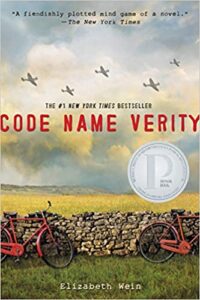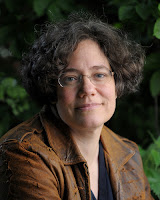By Elizabeth E. Wein
 In 1943, two good friends — Maddie Brodatt and Julie Beaufort-Stuart — are brought together for a secret wartime operation.
In 1943, two good friends — Maddie Brodatt and Julie Beaufort-Stuart — are brought together for a secret wartime operation.
Julie has an assignment from the Special Operations Executive to land in German-occupied France. Using false papers identifying her as a German liaison officer, Julie is to attach herself to Nazi headquarters in the region.
Maddie has been working as a civilian pilot transporting new and damaged planes across England. When the pilot scheduled to fly Julie to France is in a car accident, Maddie volunteers to pilot Julie’s plane.
Over France, Maddie runs into anti-aircraft gun fire that damages the tail gear of the plane. Unable to land, she sets Julie up to parachute from the plane. Then Maddie crash lands the plane.
Julie sets out on her mission, but is picked up by the Germans. It turns out that she’s accidentally taken Maddie’s identification papers. She’s thrown into a Gestapo prison and tortured. She knows she’s considered a “nacht und nebel” (night and fog) prisoner — one who will disappear without a trace. She believes she will ultimately be sent to Natzweiler-Struthof, a camp where the Germans conducted medical experiments before killing prisoners.
Half of this book is written as Julie’s confession to the Germans. She’s written it in the form of a novel. Julie never loses sight of her audience — and future audiences — as she writes. She drops in information about the layout of the building and other things that might help the Allies in the future. Although she repeatedly talks of herself as a treasonous coward, much of the information she “confesses” to the Germans is false.
The second half of the novel is written from Maddie’s perspective about what happens after Julie parachutes out of the plane and Maddie struggles to get a flight back to England. Failing to do so, she becomes part of a resistance network trying to locate and free Julie and destroy the Nazi’s regional headquarters.
This novel is deviously well plotted. Few characters can be taken at face value — or even as Julie presents them in her confession. Although ultimately heart-breaking, this is a suspenseful story of courage and daring.
The novel won the 2013 Michael L. Printz Award, the Edgar Allan Poe Award for Best Young Adult Novel and the Golden Kite Honor in 2013. It was also shortlisted for the Carnegie Medal. (Don’t let the “young adult” categorization put you off; this is a sophisticated and fascinating tale about women in wartime.)
Author Elizabeth Wein has written other books that involve some of the same characters but aren’t traditional sequels.
If you want to learn more about Julia, check out THE PEARL THIEF (2017), which features Julia as a 15-year-old and Scottish Traveler Euan McEwen, who finds her injured.
ROSE UNDER FIRE (2013) features American Air Transport Auxiliary pilot who becomes a friend of Maddie’s. Returning from a semi-secret flight near the end of World War II, Rose is captured by the Germans and ends up in Ravensbrücke concentration camp.
THE ENIGMA GAME (2020) brings together Jamie Beaufort-Stuart (Julie’s older brother), a flight leader for the 648 Squadron, 15-year-old Louisa Adair and Ellen McEwen, a volunteer driver for the Royal Air Force.
Others books about women in war that might be of interest to you include Kate Quinn’s THE ALICE NETWORK and THE HUNTRESS or Manda Scott’s A TREACHERY OF SPIES.
About the Author: Elizabeth E. Wein (1964 – )
Elizabeth Wein is an American-born novelist who has lived in England, Jamaica and the United States. She has a passion for planes and earned a private pilot license in 2003.
Her father, Norman Wein, helped set up Headstart programs at what is now Manchester Metropolitan University and at the University of the West Indies in Jamaica. He brought his family with him for both assignments.
Elizabeth and her younger brother and sister moved back to the United States with their mother Carol Flocken when their parents’ marriage broke up. Her mother died in a 1978 car accident. Elizabeth and her siblings were raised by her maternal grandparents.
A writer since the age of 11, Elizabeth attended Yale University, did a year of work-study in England and then returned to the United States to earn a doctorate in folklore from the University of Pennsylvania, Philadelphia. While there, she learned to ring church bells in the English style known as “change ringing.” In 1991, she met her future husband there at a bell rings’ dinner-dance.
She and her English husband Tim moved to England in 1995 and settled in Scotland in 2000. They have two grown children. She and her husband ring church bells every Sunday at Dunkeld Cathedral on the banks of the River Tay.



